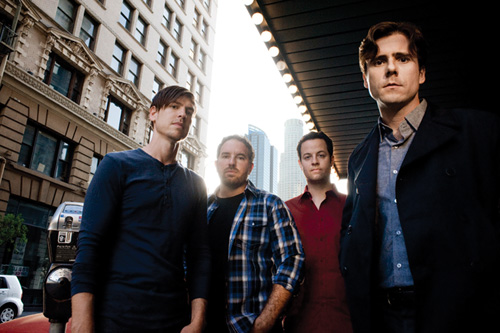arts@sfbg.com
MUSIC The term “emo” has become synonymous with whiny, tight-jeans-wearing 13-year-olds with asymmetrical haircuts. (Thanks, Hot Topic.) But stereotypical B.S. aside, in the beginning, emo — short for “emotional punk rock” — was a compelling music movement in the early 1990s and 2000s typified by melodic guitar, motley rhythms, and expressive, pour-your-heart-out lyrics.
“It went from being this really powerful, emotional movement into, like, the annoying little brother of music,” says Kristopher Hannum who co-runs Diary, an emo, screamo, and pop punk music night held every third Saturday of the month at Pop’s Bar. “But I feel like it’s slowly coming back in a good way — not in a Hot Topic-y, YouTube bands they call emo [way]. There are good things happening and they are slowly bubbling up to the surface, like [San Francisco’s] Clarissa Explains It All.” He adds, “It’s a band I point out to people that is kind of taking that [emo] scene and doing good things with it.”
But ever since the term was coined in the mid-80s Washington, D.C. hardcore punk scene, initially to describe bands such as Rites Of Spring, emo has been considered a four-letter word.
“I have never met a band in what I would consider the emo genre that ever copped to calling themselves ’emo.’ It’s weird. Fans throw that around really easily but you’ll never hear, for the most part, a band describe themselves as emo,” explains Leslie Simon, co-author of Everybody Hurts: An Essential Guide To Emo Culture (Harpers, 2007) and former MTV.com editor.
Jim Adkins lead vocalist-guitarist of Jimmy Eat World, which is heralded as a seminal emo band, rejects the label. “I’m pretty much done trying to deflect or change that perception. I don’t really consider us to be [emo]. It’s a long conversation,” Adkins says, curtly. “For me, it’s just flattering that anyone pays attention to what we do. To explain what we do, [I say] guitar-based, melodic rock music.”
Adkins’ sentiment notwithstanding, Jimmy Eat World’s 1999 release Clarity (Capitol) is often lauded as one of the most significant emo albums of the late ’90s, heavily influencing the third wave of emo (2000 — present) which includes bands like My Chemical Romance, Fall Out Boy, and All-American Rejects.
In 2001, as emo broke into mainstream media, Jimmy Eat World released its platinum-selling album, Bleed American (Dreamworks/Geffen). In its introductory title track, Adkins wails “I’m not alone ’cause the TV’s on, yeah / I’m not crazy because I take the right pills everyday” — perfectly encapsulating the angst and disillusionment of Gen Y’ers. With its empowering lyrics (“Just do your best / do everything you can /And don’t you worry what the bitter hearts are gonna say”), the anthemic “The Middle,” another track off Bleed American, reached #1 on Billboard’s Modern Rock Tracks, galvanizing wallflowers everywhere to stay true to themselves. With its impeccably relatable themes, it is no wonder why the album was the band’s biggest commercial success.
To commemorate the 10th anniversary of its release, Jimmy Eat World will play Bleed American in its entirety at the Fillmore on Monday, Sept. 26 and Tuesday, Sept. 27.
“[Bleed American] is a special record for a lot of people. It’s just been kind of a fan request that we do it, so we’re doing it in areas where we’ve always had a good time playing,” Adkins explains.
Coincidentally, Saves The Day released its first studio album in four years, Daybreak, last week. And the once-disbanded-now-reunited Get Up Kids — also wildly popular in the early-2000s — released There Are Rules earlier this year, making a stop on its tour in San Francisco, playing a show with Dashboard Confessional, another iconic emoter, most famous for its single, “Screaming Infidelities.”
Heart it or hate it, in the past year second-wave emo bands seem to be making a comeback. So this begs the question: What is behind the resurgence of this style of music?
“Playing music is an awesome opportunity. Maybe all of these people that are coming back together kind of miss it. We were really lucky that we’ve been able to continually do it,” Adkins says. “The more interesting question is why did they stop?”
“I really like to think that it wasn’t about making money which, I’m sure, half of those bands are doing it just because there are ticket sales in it, you know?” Hannum says with a hint of disillusion in his voice. “[But] I like to think that they are in a position where they can still get back together and tour to give access to these kids that couldn’t access it back then.”
“It does come off sometimes like they’re doing it for the paycheck. But, at the end of the day, who cares?” Simon replies, laughing. “I still love hearing Chris Conley (of Saves The Day) sing “Firefly” and I get a kick out of watching the Get Up Kids play “Don’t Hate Me” because those were songs that meant something to me when I was younger. And I am 22 again. It is wonderful.”
JIMMY EAT WORLD
With Kinch
Mon/26 and Tues/27, 8 p.m., $35
The Fillmore
1805 Geary, SF

